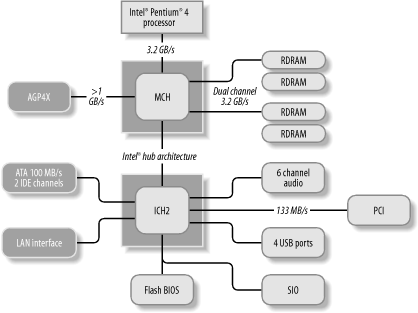Seventh-generation Intel and Intel-compatible chipset characteristics
Although AMD tried to represent the Athlon as a seventh-generation processor, (hence the initial designation of the Athlon as the K7), the first true seventh-generation processor is the Intel Pentium 4. The Pentium 4 differs dramatically in architecture from sixth-generation processors, so chipsets designed for the Pentium 4 are not merely minor upgrades of sixth-generation chipsets. A block diagram of the first Pentium 4 chipset, the Intel 850, is shown in Figure 3-7. Later Intel chipsets use a similar hub architecture, with upgraded MCH (Northbridge) and ICH (Southbridge) components. The most recent Intel chipsets use 865- and 875-series MCH Northbridges with ICH5 or ICH5R (RAID-enabled) Southbridges.

Figure 3-7. Block diagram of the Intel 850 chipset (graphic courtesy of Intel Corporation)
Current Pentium 4 chipsets are differentiated by Southbridge features, such as Serial ATA, USB 2.0, and so on, but differ primarily in the type of memory they support. Sixth-generation processors such as the Intel Pentium III do not benefit greatly from the higher bandwidth of Rambus RDRAM and DDR-SDRAM. In most circumstances, the 1067 MB/s bandwidth of PC133 SDRAM can more or less keep up with the memory bandwidth requirements of these processors.
The Pentium 4, on the other hand, can productively use much more memory bandwidth ...